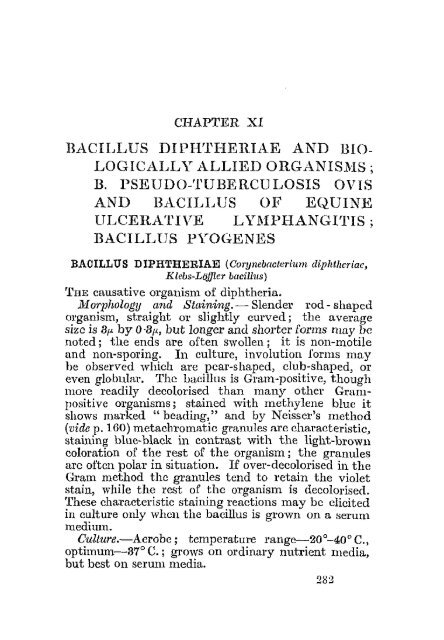AGf~ICULTURAL RESEARCH, PUSA.
AGf~ICULTURAL RESEARCH, PUSA.
AGf~ICULTURAL RESEARCH, PUSA.
Create successful ePaper yourself
Turn your PDF publications into a flip-book with our unique Google optimized e-Paper software.
CHAPTER XI<br />
BACILLUS DIPH'l'HERIAE AND BIO<br />
LOGICALLY ALLIED ORGANISMS;<br />
B. PSEUDO-TUBERCI1LOSIS OVIS<br />
AND BACILLUS OF EQUINE<br />
ULCERATIVE L YMPHANGl'l'IS ;<br />
BACILLUS PYOGENES<br />
BACILLUS DIPHTHERIAE (Corynebacterium diphthcl'iae,<br />
Klebs-Loffler bacillus)<br />
'fIlE causative organism of diphtheria.<br />
Morphology and Staining. - Slender rod - shaped<br />
organism, st.raight 01' slightly curved; the average<br />
size is 8/1. by 0 ·8p., but longer and shorter forIllS may bc<br />
noted; the ends are often swollen; it is non-motile<br />
and non-sporing. In culture, involution forms may<br />
be observed which are pear-shaped, club-shaped, 01'<br />
even globular. The bacillus is Gram-positive, though<br />
more readily decolorised than many other Grampositive<br />
organisms; stained with methylene blue it<br />
shows marked "beading," and by N eisser's method<br />
(vide p. 160) metachromatic granules are characteristic,<br />
staining blue-black in contrast with the light-brown<br />
coloration of the rest of the organism; the granules<br />
arc often polar in situation. If over-decolorised in the<br />
Gram method the granules tend to retain the violet<br />
stain, while the rest of thc organism is decolorisecl.<br />
These characteristic staining reactions may bc elicited<br />
in culture only whcn the bacillus is grown on a :serum<br />
mediulll.<br />
Cullure.-Aerobc; temperature range-20°-40° C.,<br />
optimum-37° C.; grows on ordinary nutrient media,<br />
but best on serum media.<br />
282

















